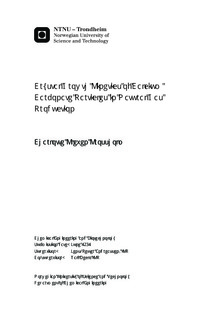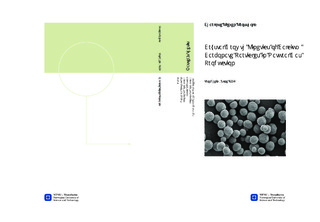| dc.description.abstract | Precipitation of calcium carbonate particles is an interesting area in natural gas production. The inorganic salt could be formed due to pH stabilization for corrosion control in the pipelines and during the regeneration of the hydrate inhibitor monoethylene glycol (MEG) onshore. Calcium carbonate is inverse soluble which implies a risk for precipitation at elevated temperatures, for example in heat exchangers, in the MEG regeneration process. Hence, it is desired to precipitate the ions; and to separate the particles from the MEG loop. Due to these issues, investigation of calcium carbonate growth is requested.
The purpose of this work has been to investigate crystal growth kinetics, by determining growth order and growth rate constants of calcium carbonate with MEG as co-solvent. Seeded growth experiments were performed for the polymorphs vaterite and calcite at 40 and 70 °C with 0 ? 70 wt% MEG. Number and size measurements of the seeds were done by use of the Coulter Counter. The depleting calcium concentration was measured by automated titration and corresponding supersaturation ratios were calculated in MultiScale to give growth rates of calcium carbonate. The crystals were analysed by a scanning electron microscope (SEM) and by powder X-ray diffraction (XRD).
The results show that the growth of vaterite and calcite is reduced by increased amount of MEG. Additionally, an elevated temperature will enhance the growth. Increasing the co-solvent composition from 0 ? 60 wt%, reduces the growth rate constants assuming parabolic rate law kg=2 for vaterite from 1.81 to 0.24 nm/s at 40 °C and from 2.12 to 0.63 nm/s at 70 °C. The corresponding reduction for calcite with a MEG concentration raised from 0 ? 70 wt% is from 0.52 to 0.02 nm/s at 40 °C and from 0.95 to 0.08 nm/s at 70 °C. It was concluded that calcite is the slowest growing polymorph in water at both temperatures.
A growth of second order was found for vaterite in water at 40 °C. For calcite the growth order at the same conditions was slightly higher. It is proposed that growth of both polymorphs in water is controlled by surface integration. The order of vaterite and calcite growth decreases with increased MEG concentration and temperature, and a change to first order kinetics is observed. Due to increased viscosity caused by the co-solvent, diffusion or adsorption controlled growth, when g = 1, is suggested. This could be explained by the lowered diffusivity of carbonate as a result of the non-stoichiometric reactant ratios. | |

